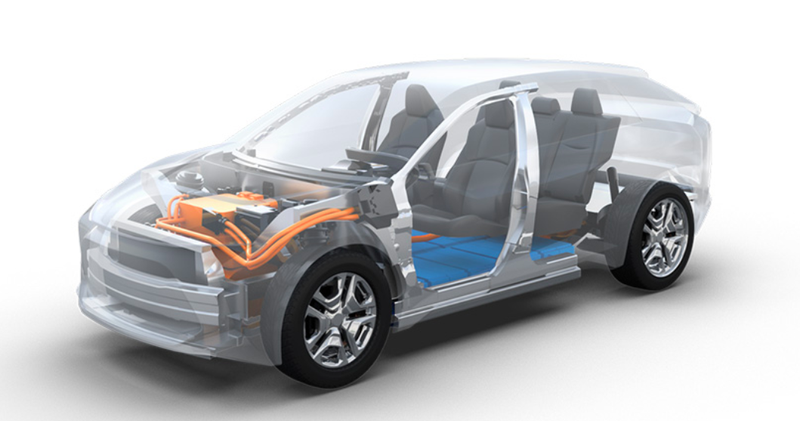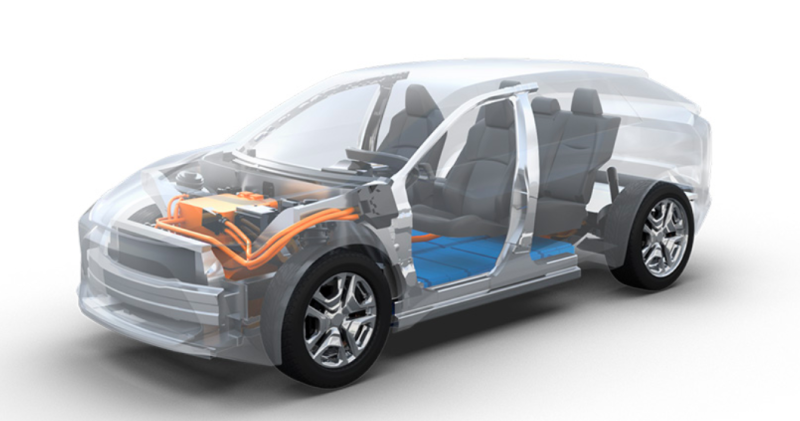
It was announced this week that Toyota and Subaru will work together on a new electric vehicle platform, one that will combine Subaru’s all-wheel drive expertise with Toyota’s electrification chops. Here’s a quick look at the new “e-TNGA” platform, which Toyota states will underpin future mid-size and large electric passenger vehicles and contribute to the company’s goal of selling 1 million battery-electric and fuel-cell cars by 2025.
Yesterday Toyota’s executive vice president Shigeki Terashi made a presentation entitled “Aiming to Popularize BEVs,” which provided a roadmap for the company’s future electric vehicle development. Key to the plans he highlighted is a new platform to be developed alongside Subaru.

Called “e-TNGA,” the platform follows a similar modular strategy as the Toyota New Global Architecture (TNGA) that underpins much of Toyota’s current unibody lineup of cars and SUVs. That is to say that e-TNGA should afford the company the ability to build a vast range of vehicles on one basic set of bones, as Toyota describes in the excerpt below from its press release:
The platform will be developed in a way that will make it broadly applicable to multiple vehicle types, including C-segment-class and D-segment-class sedans and SUVs, as well as to efficient development of derivative vehicle models.
Advertisement
The graphic below goes into further detail on how Toyota and Subaru will accomplish this One Platform for Many Vehicle Types goal:

Based on the slide above, it appears that the cross-car provisions for the motor and battery mounts will remain the same across e-TNGA variants, but wheelbase (and battery length), front and rear overhangs, and overall vehicle width can vary. There are also likely provisions in place to allow for variations in motor size.
Advertisement
Here’s a look at the specific parts that the two automakers will alter as they adapt e-TNGA for SUVs and sedans of various shapes and sizes:

The platform looks similar to that of the Tesla Model 3, and shares a number of attributes with Volkswagen’s MEB setup; the batteries are located between the axles in the floor, and two motors—one up front and one out back—are available to allow for rear and four-wheel drive.
Advertisement
But unlike Tesla or VW, Toyota advertises its new platform as capable of offering front-wheel drive as well.
(Tesla and VW could theoretically do it, but the latter has specifically stated it plans for only rear and all-wheel drive variants, and I’ve also heard nothing from the former about front-drive.)

Advertisement
But it’s not just Subaru that Toyota is working with to develop EVs. Terashi mentioned in his presentation that his company is collaborating with Daihatsu and Suzuki on compact models:

And speaking of compact electric vehicles, Toyota has plans to build ultra-compact EVs for Japan by 2020:

Advertisement
Terashi showed three ultra-compact vehicles in his presentation. There’s the commercially planned model shown above, there’s a black “business concept model,” and there’s the “i-ROAD,” a 37 mph three-wheeler with 31 miles of max cruising range and a goal to—per Toyota—“serve as the last-mile in urban areas.”

In addition, Toyota has laid out plans to put three walking-area EVs into production, with the stand-up type one shown below expected by 2020, and the seated and wheelchair-linked types to come in 2021:

Advertisement
In announcing Subaru and Toyota’s plans to work together on the new dedicated electric car platform, Toyota mentioned that the new bones will form the basis of an upcoming mid-size SUV that both companies will jointly develop and sell under their respective brands.
In addition, Toyota described in its press release on Thursday that the partnership “will apply Subaru’s all-wheel-drive technologies and Toyota’s vehicle electrification technologies.” The first part of that is interesting, since Subaru’s expertise generally lies in all-wheel drive systems for internal combustion engine vehicles, and all-wheel drive setups for EVs tend to be quite different.
Still, I bet various traction control strategies used in ICE cars could also apply to EVs, so it’ll be interesting to see what the two companies come up with.
Advertisement

Toyota also mentions in its press release how the current social and political climate has necessitated this Subaru partnership:
…due to significant variation in the energy situations of each country or region and in government policies, as well as due to resulting differences in environmental regulations, in the stages of infrastructure preparation, and in market needs for electrified vehicles, efficient and speedy development of appropriate products is a must.
Furthermore, the commercialization of BEVs requires the use of large-capacity batteries, and, along with the popularization of BEVs, demands of a new dimension will be placed on battery supply. In addition, stemming from differences in how cars will be used due to maximum cruising ranges and the state of infrastructure construction, sales methods with a new approach will also be needed.
These and other issues present a growing number of challenges related to costs, supply, and ways of selling.
Advertisement
There’s a lot more to Toyota’s presentation, including planned collaborations between the automaker and a number of companies—including Panasonic, BYD, CATL, Toshiba, GS Yuasa, Toyota Industries—in order to help with battery procurement. That tends to be a big deal in the automotive EV space.
It’s an interesting move by Toyota, an automaker that was an early successful pioneer in hybrid cars but has been quite conservative when it comes to fully electric vehicles until now. It’s a big deal on Toyota’s part, even if it’s not as huge as what Volkswagen is planning to do.
You can watch Terashi’s full remarks below:













